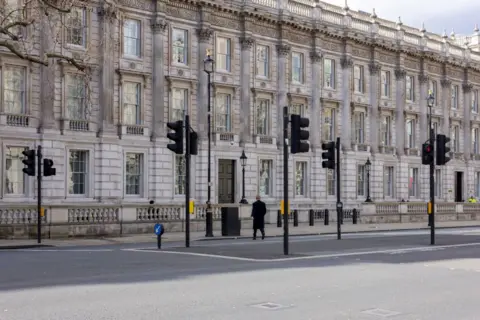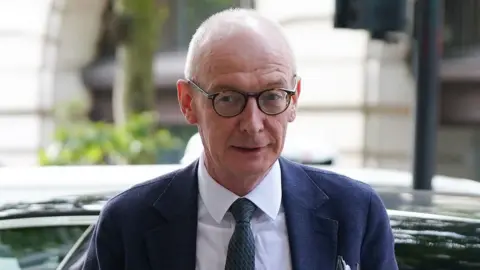Newscast presenter
 Getty Images
Getty ImagesFor years, we have reported from outside so-called Cobra meetings.
It’s where collections of senior ministers and officials gather in central London, to coordinate the emergency response to a crisis – COBR stands for Cabinet Office Briefing Rooms.
Neither of us has ever been inside. And never before has anyone broadcast from inside, until now. The BBC’s Newscast podcast was invited to take a look.
Mobile phones, cameras and other electronic gizmos surrendered, we squeezed along narrow corridors and down stairwells, including a bit of the building that was Henry VIII’s tennis court.
The main, windowless room is behind a white metal door a good few inches thick.
We admitted to each other on the way in that we were prepared to be underwhelmed – perhaps, after years of imagining these rooms, they would feel like any other office.
But they don’t. Somehow they leave you with a lasting impression of the gravity of the decisions taken in here.
A long rectangular table dominates the main room. Chairs run down either side, with one chair at its semi-circular head.
When the prime minister addresses the cabinet, not far away in 10 Downing Street, he is primus inter pares, first among equals, sitting among his or her ministers.
There is no such subtlety here: the chair of the meeting, so often the prime minister, is unquestionably the central character.
Straight ahead, the entire back wall of the room is taken up by a screen. Huge monitors hang too on both other main walls.
A digital clock tells us the time here, the time in Washington DC and the time in New Delhi – the room was recently used after the plane crash involving the Air India jet flying from Ahmedabad to London Gatwick.
At first, the brightly-coloured pictures on the wall from the government art collection seem out of place, but after a few minutes in this windowless room you can see why stressed ministers might appreciate a second or two of calm.
A few corridors away there is the National Situation Centre or SitCen.
The civil servant who runs it is a guy called Roger Hargreaves.
He and his team exude a pride in what they have recently assembled.
The pandemic changed everything: cruelly exposing, like little before it, the inadequate nature of contingencies, preparedness and, crucially, coordination in the event of something on the scale of Covid.
Perhaps anticipating the criticisms still to come from the Covid Inquiry and others, Whitehall is clearly keen to make the case that it has upped its game.
But what might lie around the next corner?
“There is a risk in all of this that you prepare perfectly for the last war,” Pat McFadden, the senior minister here, acknowledges candidly.
In other words, you assiduously learn the lessons of the last crisis and then the next one, which is totally different, floors you all over again.
We are talking to McFadden in the main briefing room, as he announces plans for a national test of the government’s emergency alert system – where the majority of the 87 million mobile phones in the country get a message at the same time.
The next test will happen on Sunday 7 September at 15:00 BST.
“It’s the country-wide equivalent of somebody testing their fire alarm or their smoke alarm. It’s been developed in recent years. It’s a really valuable system of communication between the government and public in emergency situations,” the minister tells us.
 PA
PAIn the National Situation Centre, data lies at the heart of the operation.
Our modern, digitised world generates oodles of it and this place has access to one heck of a lot of it, plenty of it in real time.
We are shown how datasets on almost anything you can think of can be called up, and then overlaid one upon an other in response to a particular event.
“The way that we think about vulnerability has changed. Covid exposed a lot of cracks in society about who was affected most severely,” McFadden says.
“So in the Situation Centre, we have this vulnerability map now that when there is an emergency situation, we will have a better idea of who really needs help, who’s totally dependent, who maybe is less able to do things on their own.”
How is one of those maps compiled?
“Well, for example, energy companies will have a register of their most vulnerable customers, the people who you might want to reconnect first or the people you know if they’re disconnected. They are perhaps elderly, frail, dependent on certain medical supplies, all of this kind of thing to try to map out in a particular situation because resilience has to be for everybody, it can’t just be for some,” the minister adds.
This whole place feels like government at its most core, its most raw: none of the usual yah boo party politics, but a bunch of people trying to keep us safe or provide support in the most horrendous situations.
They very fact they invited us in tells you they think they have learned the lessons of recent years.
But the perpetually unanswerable question is whether they will be up to whatever comes next.








